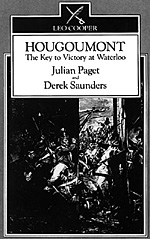 Authors: Julian Paget and Derek Saunders
Authors: Julian Paget and Derek Saunders
Pages: 112
Illustrations: 8 black and white reproductions of period paintings and illustrations; 9 photos of the chateau as it appears today.
Maps: 7, including the layout of the site today, a diagram of seven separate French assaults, plus maps noting Allied division and brigade positions and the French Middle Guard attack on the Allied line near Hougoumont at the end of the battle.
Footnotes: 75, many annotated
Appendices: 4, including Sequence of Events, Personalities, Allied Troops and Artillery and French Forces Engaged, and Selected Bibliography.
Bibliography: 18 sources noted
Index: 225 entries
Publisher: Leo Cooper, an imprint of Pen & Sword Books, Ltd., London, England (available through Combined Books in the U.S.)
Publication Date: 1995 (reprint of original 1992 edition)
Binding: Cloth (hardbound)
ISBN: 0-85052-3419
Price: $16.95
Summary: This slender volume (perfectly sized for travel) tells the story of the fight for Hougoumont, and should serve as a wonderful guidebook for those readers planning to visit the famous site. Paget and Saunders have written an entertaining and informative account of the struggle that may indeed have sealed Napoleon's fate at Waterloo.
The defense of Hougoumont has become one of the legendary feats of the British Guards; it is a story with immortal appeal, being that of a beleaguered garrison, vastly outnumbered, holding on against the repeated assaults of an equally determined and heroic opponent. Authors Julian Paget, who served in the Coldstream Guards and is the editor of The Guards Magazine, and Derek Saunders, who has devoted 20 years to his study of the British Army at Waterloo, do a fine job telling the story from its more compelling perspective; that is, from the British point of view.
The book begins with a detailed description of Hougoumont at the time of the battle, complete with pictures and diagrams. What is not immediately apparent to the casual visitor to Hougoumont is that the largest structure, the chateau itself, was destroyed in the battle. Saunders and Paget provide a nice description of the immediate terrain as it existed that fateful June.
Thankfully, the authors do not spend a great deal of time rehashing the 1815 campaign itself. However, in Chapter Three, they do provide enough information for the reader unfamiliar with the Hundred Days to place the fight at Hougoumont into some context.
Rely on Memoirs
By largely relying on British memoirs, Paget and Saunders bring the story of this garrison to life. From the misery caused by the terrible rainstorm the night before the battle, to the final scenes of horror and carnage, the book deftly integrates the military tactics of the fight with the gritty story of the men who fought there. Too often, military histories ignore one consideration in favor of the other, but Paget and Saunders seem to have come to terms with the need to tell both the story of the privates, like Matthew Clay of the Third Guards, as well as that of the generals and colonels.
There are some nice tidbits for the more serious military buffs here as well. No doubt, readers will appreciate that the authors have broken down the confusing events into seven distinct French attacks, which helps organize the narrative and prevents it from becoming too bewildering. In addition to the diagrams and drawings, which are worth keeping handy during other Waterloo readings, a nice order-of-battle exists in the end. Even more interesting is a detailed chronology of the events at Hougoumont, which can be compared with other accounts of the battle to place things in further perspective.
The book returns in the end to the topic of Hougoumont itself as a historic site, and provides contemporary photographs and recommendations for touring the existing works. Perhaps this is the book's chief asset, as it makes a wonderful, and extremely useful guide to take to Belgium when you visit the battlefield. It is also a worthy addition to any collection of Waterloo titles.
More Book Reviews:
Back to Table of Contents -- Napoleon #7
Back to Napoleon List of Issues
Back to Master Magazine List
© Copyright 1997 by Emperor's Press.
This article appears in MagWeb (Magazine Web) on the Internet World Wide Web.
The full text and graphics from other military history magazines and gaming magazines are available at http://www.magweb.com